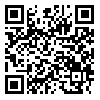Volume 18, Issue 1 (2021)
ioh 2021, 18(1): 319-333 |
Back to browse issues page
Download citation:
BibTeX | RIS | EndNote | Medlars | ProCite | Reference Manager | RefWorks
Send citation to:



BibTeX | RIS | EndNote | Medlars | ProCite | Reference Manager | RefWorks
Send citation to:
Tabatabaei S, Hasanvand M. Study of Ergonomic Workstations and It’s Relation with Prevalence of Musculoskeletal Upper limbs Disorders and It’s Relation with Psychosocial Factors in Staff of Lorestan Province Banks. ioh 2021; 18 (1) : 21
URL: http://ioh.iums.ac.ir/article-1-2473-en.html
URL: http://ioh.iums.ac.ir/article-1-2473-en.html
Shahid Beheshti University of Medical Sciences , mostafa.hasanvand85@gmail.com
Abstract: (2534 Views)
Introduction: The staff of bank are often on the exposure of repeated movements, awkward posture and working by hand also, they encounter with psychosocial problems at workplace. Therefore, this research conducted with the aim of study of Ergonomic workstations and its relationship with prevalence of upper limbs disorders and psychosocial factors in the staff of Lorestan province banks.
Methods and Materials: This was a practical and descriptive- correlative research. The statistical population consisted of 900 employees of banks in Lorestan province, with a sample of 275 who were selected by stratified cluster sampling. Data was collected by these questionnaires: Demographic; Ergonomic Checklist of Occupational Safety and Health Administration (OSHA); Nordic (Kuorinka,1987); and Psychosocial Factors (Hersey and Goldsmith 1980). To analysis of data (t-test and multiple regression) were used by SPSS23.
Results: The highest prevalence of upper limbs disorders observed in the neck (61.5%) and the shoulder (53.8%). The mean of psychosocial factors in the staff of Lorestan province banks was found to be a little more than average. It was found to be significant difference between means of sample group in psychosocial factors with respect of their evaluation of physical and mental work condition (α ≤ 0.01). There was a significant and negative correlation between all ergonomic indexes with upper limbs disorders and psychosocial factors with these disorders(p≤0.01).
Conclusion: Psychosocial situation of the staff is in the average. However, managers should be aware of the needs of the staff. Furthermore, the staff need to perceive social support, motivation, and feedback from their supervisors to work efficiently.
Methods and Materials: This was a practical and descriptive- correlative research. The statistical population consisted of 900 employees of banks in Lorestan province, with a sample of 275 who were selected by stratified cluster sampling. Data was collected by these questionnaires: Demographic; Ergonomic Checklist of Occupational Safety and Health Administration (OSHA); Nordic (Kuorinka,1987); and Psychosocial Factors (Hersey and Goldsmith 1980). To analysis of data (t-test and multiple regression) were used by SPSS23.
Results: The highest prevalence of upper limbs disorders observed in the neck (61.5%) and the shoulder (53.8%). The mean of psychosocial factors in the staff of Lorestan province banks was found to be a little more than average. It was found to be significant difference between means of sample group in psychosocial factors with respect of their evaluation of physical and mental work condition (α ≤ 0.01). There was a significant and negative correlation between all ergonomic indexes with upper limbs disorders and psychosocial factors with these disorders(p≤0.01).
Conclusion: Psychosocial situation of the staff is in the average. However, managers should be aware of the needs of the staff. Furthermore, the staff need to perceive social support, motivation, and feedback from their supervisors to work efficiently.
Article number: 21
Type of Study: Research |
Subject:
Macro Ergonomics
Received: 2018/06/24 | Accepted: 2019/09/13 | Published: 2021/01/2
Received: 2018/06/24 | Accepted: 2019/09/13 | Published: 2021/01/2
Send email to the article author
| Rights and permissions | |
 |
This work is licensed under a Creative Commons Attribution-NonCommercial 4.0 International License. |







